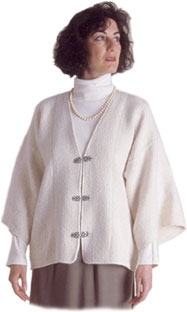 |
|
 |
|
|
I had an opportunity to read this book and to try out some of the patterns. I have intermediate sewing skills and I found this book quite easy to follow. And it works! Using some of my handwoven foxfibre cotton fabric, I used the Kimono pattern from Susan's book and achieved excellent results.
The patterns use narrow warps that will accommodate most looms (24" - 30") and are drawn on a grid with full cutting layouts. Different sewing techniques are described. How to make your own bias tape
former About Weaving web site now All Fiber Arts - see links
I've been weaving nearly thirty years and found Clothing
Pattern from the Weaving Room a useful book. It follows the ancient
historical teachings of using material straight off the loom, which is a wonderful
way to make loose fitting garments....
|
jjjjjjjjj |
Clothing Patterns from the Weaving Room is a wonderful resource for students. The approach to garment construction is especially useful for the beginning handweaver. Susan Lilly's clear direction and reliance on large basic shapes makes construction fun and accessible. Barbara Setsu-Pickett Associate Professor, Fiber Area, Department of Art, University of Oregon We all aspire to make something from our looms for ourselves and for those we love. Scarves, shawls, table runners, and throws cover many surfaces in our homes. The next logical step would be clothing, except few of us are trained in the skills necessary for proper pattern fit and engineering. Thus, classic loom-shaped clothing, rectangular shapes sewn right from the loom, appeal to many weavers--designs are simple, selvages are used, and construction details are minimal. It is with this type of clothing that Susan Lilly excels, and her book covers the design, fit, and construction of simple shapes from the loom. ...Ms. Lilly makes terrific use of selvages so that minimum seam finishes are required. Her construction rules "are general and are made to be broken once in a while." There are no darts, no intertacings, no buttonholes, no sleevecaps, no hand sewing, no padding, no lining--no kidding! ...there are few books on garments for handweavers currently in print. Lilly's book gives basic information and layouts of many of the classic handwoven silhouettes. For those wishing to expand their repertoire and to create simply-shaped garments from basic rectangles, Lilly's book is a basic addition to a handweaver's library. Daryl Lancaster - from Shuttle Spindle & Dyepot - Summer 2001 Published by Handweavers Guild of America, Inc. Two Executive Concourse, Suite 201 3327, Duluth Highway, Duluth, GA 30096-3301 |